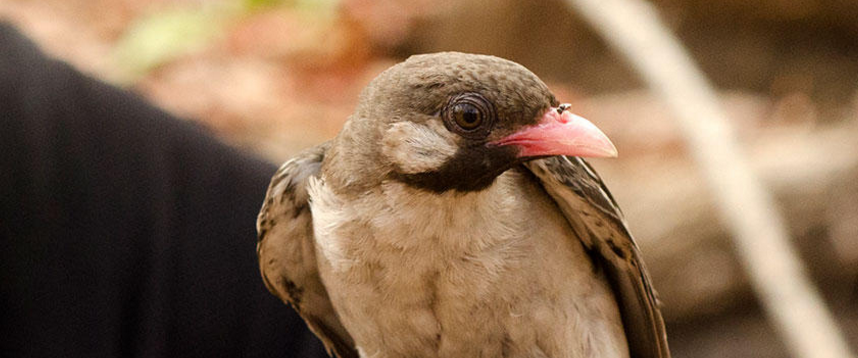Audubon Blog: The Greater Honeyguide
Contributed by Bill Hamilton
The Greater Honeyguide (which has possibly the most functionally defining speciesname in nature: Indicator indicator) is a bird of sub-Saharan Africa found primarily in the open, dry forests scattered across that continent. The Greater Honeyguide is a thrush-sized bird (7 ½ to 8 inches long) with relatively drab colorings (brown back, white belly and cheeks, with some yellow on their shoulders). They are evolutionarily related to woodpeckers, but are very cuckoo like in their reproductive strategies: they are obligate nest parasites.
Greater Honeyguides parasitize the nests of 40 different species of birds. They are especially attracted to hole nesting species (including Woodpeckers, Bee-eaters, and Barbet birds). To increase the chances for their potential success in its nest, Greater Honeyguide hatchlings are born with sharp hooks on the ends of their bills which they use to kill their fellow nestlings. All of the parentally delivered food, then, goes directly to the rapidly growing honey guide nestling.
A paper was published last summer in Science (July 22, 2016) in which the communication biology between humans (members of the Yao people of Mozambique) and the Greater Honeyguide bird was examined. The Yao regularly search for honey in the forests around their villages and often recruit a honeyguide bird to assist them in finding the honey-rich bee nests.
Birds that participate in successful hunts are rewarded with a piece of honeycomb (a highly desirable food item for the bird!). The Yao use particular vocalizations (especially a “brrr-hum” sound) to attract and maintain contact with their Greater Honeyguides. Scientists from the University of Cambridge and several institutions of South Africa wanted to determine if the vocalizations used by the Yao were specific to triggering Greater Honeyguide attention and behavior, or if more generalized sounds directed at a passing bird would also elicit the mutualistic hunting behavior.
Using high quality recordings in the field, these scientists clearly showed that the specific “brr-hum” call was interpreted by the Greater Honeyguides as a call to join humans in a hunt for bees’ nests. The honeyguides do feed on bee’s wax on their own, but approaching a bee nest can be quite a dangerous task for them. Multiple bee stings can actually kill an adult Greater Honeyguide. So, the mobilization of humans with their technologies (axes, saws, and smoke) greatly reduces the probability of injury and greatly increases the likely of a good meal of bee’s wax at the end of the day.
Anthropologists classify this vocalization specialization between humans and honeyguides as a true and possibly quite recent co-evolutionary event. The Yao, of course, learn this relationship as a generationally conveyed component of their complex culture. It would be interesting to see if the Greater Honeyguides also learn their roles in the hunt as a cultural trait passed down from parents to offspring, or if there is a more hardwired, genetic component to their behavior.
There are stories, by the way, and even some You-Tube videos to “back” them up, that honeyguides also have honey-gathering symbioses with animals other than humans. Their alleged interactions with Honey Badgers, in particular, have drawn a great deal of popular and scientific attention. Honey Badgers are relatively large, remarkably strong weasels that are found throughout Africa and also into southwest Asia and India. These very adaptable omnivores, as their name implies, are very fond of honey and would undoubtedly benefit from the assistance of a Greater Honeyguide.
Most of the food energy for a Honey Badger, though, comes from other sources (including a wide variety of prey (from insects to tortoises to snakes to birds), carrion (including fresh lion kills), fruits and vegetables). It is more likely that a Honey Badger would eat the Greater Honeyguide rather than reward it for helping to locate a bee nest.
